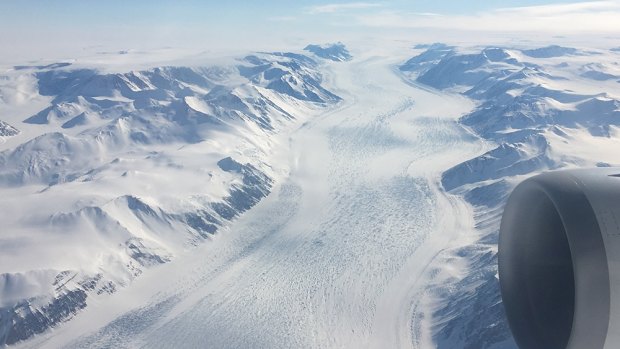
A glacier cutting a path across Antarctica.Credit: Kylie McLaughlin
Antarctica is no longer out of reach for those with a limited supply of cash and spare time – you can now reach the icy continent in one day for a cost as low as $1100.
Captain's Choice charter Qantas Boeing 747-400 flights four times a year direct from various Australian capital cities, usually Melbourne and Sydney with occasional trips from Perth and Adelaide.
This trip makes Qantas the only international airline to fly to all the world's continents. They've been flying sightseeing trips to Antarctica now for 22 years.
It takes around 4 hours to reach Antarctica, and if you've got a window seat you want to keep an eye out for icebergs three and a half hours into the trip.
A further four hours is spent travelling across the continent, and four returning to Australia.
You'll be treated to the usual perks of long-haul flights such as a drink service and meals, and if you're in premium economy as I was, a lunch and dinner menu featuring Neil Perry dishes. Seats differ in price according to position, with aisle, and seats over wings being cheapest right through to business class, which affords the best views.
There are 19 different routes to ensure the very best sightseeing is possible on each flight – cloud cover and inclement weather can mean last-minute changes occur to the original plan, but are not common.The flights only operate during the southern summer between November and February when there are 24 hours of Antarctic daylight and skies are clear.
Once you hit the continent, the aircraft flies at an altitude of 3077 metres above sea level or 615 metres above the highest ground within 100 nautical miles (180 kilometres).
The pilots and staff are just as excited to see the scenery as any of the passengers, and for most of the crew, it's the first time flying this route. In particular, the pilots really enjoy making this trip as it allows them to take control of the aircraft, dips and tips of the plane ensure all passengers get an opportunity to see the phenomenal scenery from both sides.
To help you understand the scenery, Antarctic specialists are employed to provide commentary on the flight. On this trip, we had Di Patterson on board, who was the first woman in the world to lead an Antarctic research station, managing a team of 25 during nine months of isolation over a polar winter; Rachael Robertson, who led a research expedition for 12 months, and David Dodd, who is considered an Antarctic veteran with two winters in Antarctica under his belt.
There are videos to watch before you hit the continent (as well as the usual in-flight entertainment) including a useful documentary on a Melbourne couple who decided (at the last minute – four months out) they wanted to spend 12 months in Antarctica. The video details the work that went into organising that trip – and supplying it for another 12 months should their rescue boat not be able to plough through the ice on their way to collect them.
The flight takes a direct route south and flies over the Ross Ice Shelf and the dry valleys, an unlikely spectacle on Antarctica's landscape. The McMurdo Dry Valleys are one of the world's most extreme deserts, made up of chocolate-brown mountains spread with wedding-cake icing-ice and turquoise-coloured lakes at their base. These lakes rank among the world's most saline, with a higher salinity than that found in the Dead Sea.
You'll spot numerous, huge glaciers that penetrate through the landscape to lick the shoreline. Ice sheets apparently shattered into thousands of jagged-edged pieces like an impossibly difficult jigsaw puzzle. Red ships plough through them navigating their way through to their respective bases, leaving long pathways cutting through the ocean in their wake.
You'll see bizarre, massive white lines across the ocean whipped up by strong Antarctic winds. Volcanoes, such as the notorious Mount Erebus, completely blanketed in snow, which let out the occasional puff of smoke, just to let you know that it's still alive under there. Enchanting as it is dangerous, it's the scene of one of New Zealand's worst disasters.
I found myself questioning how creatures manage to live in such a harsh environment. You can't see the wildlife, but it's there – our guides point out penguin and seal colonies and where you are likely to spot minke whales.
My camera, already on its second charge, runs out of space just after the American McMurdo Base as we start backtracking towards Melbourne.
Around 40,000 people have done this sightseeing trip since 1994, over 120 flights, and it's easy to see why anyone curious about Antarctica would take this quick and easy day trip.
But for me, and I imagine many others, it only fuels a deeper curiosity to see this fast-disappearing landscape and its inhabitants much more closely.
The writer travelled as a guest of Antarctica Flights, antarcticaflights.com.au
Sign up for the Traveller Deals newsletter
Get exclusive travel deals delivered straight to your inbox. Sign up now.